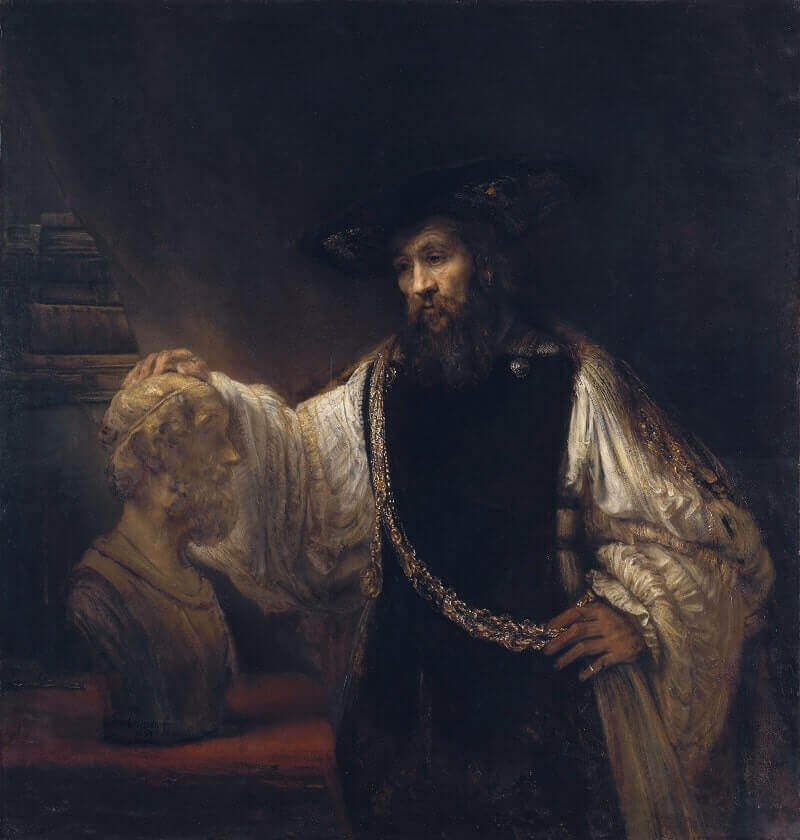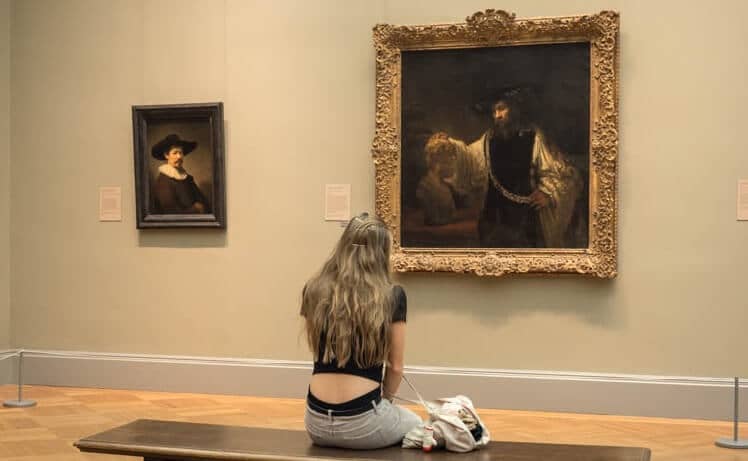Aristotle with a Bust of Homer, 1653 by Rembrandt

Rembrandt's fame reached far beyond the frontiers of the Netherlands, as is clear from a commission Rembrandt received in 1653 from Sicily. Don Antonio Ruffo, a rich art collector in Messina, had conceived the plan of hanging a series
of portraits of famous men in his library, and sent to the Dutch painter Rembrandt van Rijn to paint a portrait of a philosopher for the series. Whether it was Ruffo who decided that the philosopher should be Aristotle is not known. For
a Dutchman, the choice was obvious. In the Netherlands the classical philosopher par excellence was Aristotle, and his work was a compulsory subject in Dutch universities. Rembrandt himself would undoubtedly have studied Aristotle during
his years at the Latin school.
Rembrandt portrayed Aristotle in a quite specific role, as tutor to Alexander the Great, to whom, according to tradition, he had taught the art of war with the aid of quotations from Homer. That is why Aristotle's hand rests on a bust
of Homer, the blind poet; that, too, is why he is wearing a chain on his chest with a medallion showing a likeness of Alexander the Great.

But apart from these more material reasons for representing Aristotle in this way, Rembrandt may also have meant to represent his basic teachings. Aristotle distinguished three modes of human life, the poetic, the contemplative and the
active. The three characters appearing in the picture are representatives of these three modes - poet, philosopher and warrior.
Rembrandt probably painted the bust of Homer from a plaster cast which according to the 1656 inventory he had in his studio. He also possessed a likeness of Aristotle, but what it looked like, and whether he in fact used it for the
painting, is not known. In any case Aristotle is not in classical dress; he is in the clothes in which scholars were often portrayed in the sixteenth century - a wide light-coloured garment, with over it a long dark apron, and a wide hat.
As for the likeness of Alexander on the medallion, Rembrandt used as a model a medallion then believed to represent Alexander, although it was later shown to be a likeness of the goddess Pallas Athena, armed and helmeted.
In 1654 Rembrandt's painting was ready and it was shipped to Messina. Rembrandt had received his payment, 500 guilders, a year earlier; Ruffo thought it a large sum, and more than an Italian painter would have asked. Other commissions
for the gallery of famous men went to the Italians Guercino and Mattia Preti. In 1661 it was Rembrandt's turn again, a commission for a Homer and an Alexander the Great. Communication between painter and customer did not proceed
as smoothly as before: Ruffo was not satisfied with the work the Dutch painter sent him. The matter was never entirely cleared up to the satisfaction of both parties.




















